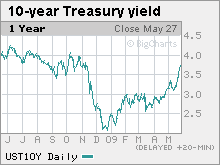Bonds rise after auctions
With the week's 3 major debt auctions complete, the yield on the benchmark 10-year note hovered at a 6-month high earlier in the session.
NEW YORK (CNNMoney.com) -- Government debt prices rose Thursday after the benchmark 10-year yield had hovered at a 6-month high earlier in the session, at the last of three major auctions scheduled for the week.
The benchmark yield had edged up to 3.72% midway through the afternoon, surpassing the 3.71% reached in Wednesday's selloff, and was the highest the yield has been since mid-November. Yields eased by late afternoon.
Treasury sold $26 billion in 7-year notes, the final portion of a $101 billion debt sale this week. The auction has a bid-to-cover ratio of 2.26, with almost $59 billion in debt coming in for $26 billion of debt sold, indicating some strength.
The auction for the relative newcomer to the field posed the greatest challenge to the market, as demand for longer-dated debt is waning compared to shorter term debt.
"For other central banks, buying is centered on the short end of the yield curve," said Mary Ann Hurley, vice president of fixed income trading at D.A. Davidson. "There is a lot less uncertainty for shorter maturities versus longer maturities."
The government sold $40 billion in 2-year notes Tuesday and $35 billion in 5-year notes Wednesday. The debt sale has contributed to a ping-ponging market, with prices sinking Wednesday as yields surged to 6-month highs, then recovering a little Thursday.
The government has been issuing an unprecedented amount of debt to finance its multi-pronged bailout for the economy. With so much supply hitting the market, investors are wary that there will be enough demand to sop up Uncle Sam's overflow of debt.
Investors had been concerned about the creditworthiness of the United States after Standard & Poor's lowered its outlook for the United Kingdom last week to "negative," due to its heavy debt burden. But another major ratings agency, Moody's came out Wednesday confirming the AAA credit rating of the U.S., soothing some of that anxiety.
Yield curve: The benchmark yield curve, which measures the difference between the yield on the 10-year note and the 2-year note, narrowed to 267 basis points.
It had widened to 274 basis points, a near record spread, earlier in the session as the 10-year yield spiked. On Thursday, the yield was at 273 basis points.
A steeper benchmark yield curve typically signals the economy is headed for recovery, because investors should be rewarded more for keeping their funds tied up for a longer period of time.
However, in this recession, things are a little different. The 2-year yield is locked in place with the key federal funds rate at a target near zero. The benchmark yield has been pushed higher by the massive amount of supply.
"The Fed policy is anchored on hold at 0 to 0.25%," said Hurley. "All of the debt that is being issued and thoughts that the economy may be bottoming here are raising inflationary expectations, that is causing the curve to widen."
Housing factor: The reason that markets care about bond yields is that lending rates move in tandem with Treasury yields. The 30-year fixed mortgage rate moves off the benchmark yield, and with the yield on the 10-year note surging, the market fears that mortgage rates could work higher. A rally in home mortgage rates would threaten a recovery in the housing market.
In an effort to fight higher yields, the Federal Reserve has embarked on a campaign to buy back $300 billion of its own debt, a program called "quantitative easing." The Fed will buy an undisclosed amount of debt next week.
The Fed is buying back debt because "they want mortgage rates lower, they want to find a bottom for housing prices, they want to support the housing sector, they want the economy to improve," said Hurley. "They have to try."
But mortgage rates are on the way up. According to a weekly survey released by Bankrate.com Thursday, the 30-year fixed mortgage rate jumped to 5.45% in the most recent week, up from 5.24% in the week prior.
Some analysts argue that the Fed's buyback campaign is not nearly big enough to combat the expanding debt load.
"What the Fed is buying back is a drop in the bucket compared to what the Treasury is issuing," said Hurley. "Given what the Treasury is issuing in debt, it is going to be very difficult for the Fed to counteract that."
Bond prices: The benchmark 10-year note jumped 20/32 to 95 22/32 and its yield edged down to 3.65% from the 3.71% hit Wednesday, which was the highest the benchmark yield had been since November 2008. Bond prices and yields move in opposite directions.
The 30-year bond rallied 1 29/32 to 95 25/32, reversing course after plummeting almost 2 points Wednesday. Its yield dipped to 4.51% from 4.6%.
The 2-year note edged down less than 1/32 to 99 25/32 and its yield was 0.98%. The yield on the 3-month note fell to 0.14% from 0.17%.
Lending rates: One key bank-to-bank lending was slightly off a record low. The 3-month Libor was 0.67% Thursday, up slightly from the record low of 0.66% set a couple days prior, according to Bloomberg.com.
Meanwhile, the overnight Libor rate was unchanged at 0.26%.
Libor, the London Interbank Offered Rate, is a daily average of rates that 16 different banks charge each other to lend money in London. The closely watched benchmark is used to calculate adjustable-rate mortgages. More than $350 trillion in assets are tied to Libor. ![]()


